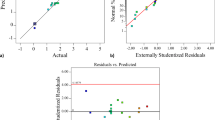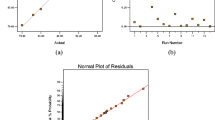Abstract
A growing generation of waste cooking oil (WCO) and its inappropriate disposal has led to the worsening of serious environmental problems. Thus, such a massive amount of WCO generated by household consumption and the food industry encourages the development of new technologies for reusing it to produce products of high economic value. The use of lipases in enzymatic hydrolysis of WCO allows employing the free fatty acids (FFA) and glycerol in the production of various bioproducts in oleochemical industries. Enzymatic hydrolysis offers advantages if compared to conventional processes of FFA production (Colgate-Emery), as it can operate under milder pressure and temperature conditions and high substrate specificity, resulting in high purity products and reduced by-product formation. Therefore, a simultaneous use of three different types of lipases in WCO hydrolysis was evaluated. For such a purpose, a simplex centroid mixture design (SMD) was used to model the influence of lipase composition on hydrolysis yield. Three commercial lipases were used: Burkholderia cepacia (LBC), Rhizopus oryzae (LRO) and porcine pancreas (LPP). Results reveal that high reaction yields of approximately 97% hydrolysis were achieved. SMD provided optimal conditions for lipase mixtures and higher hydrolysis yield, resulting in 15% LPP lipase and 85% LBC.
Graphical Abstract





Similar content being viewed by others
References
Mohamed RKMH, Renendran C, Yacob P (2012) A study on turnover intention in fast food industry: employees’ fit to the organizational culture and the important of their commitment. 9–42
de Araújo CDM, de Andrade CC, de Souza E, Silva E, Dupas FA (2013) Biodiesel production from used cooking oil: a review. Renew Sustain Energy Rev 27:445–452. https://doi.org/10.1016/j.rser.2013.06.014
Montebelo N di P, Araújo WMC, Borgo LA, Botelho RBA (2007) ALQUIMIA DOS ALIMENTOS, 3rd ed. Editora Senac, Brasília
Barbosa MS, Freire CCC, Almeida LC et al (2019) Optimization of the enzymatic hydrolysis of Moringa oleifera Lam oil using molecular docking analysis for fatty acid specificity. Biotechnol Appl Biochem 66:823–832. https://doi.org/10.1002/bab.1793
Pinto-Coelho RM (2009) Reciclagem e desenvolvimento sustentável no Brasil. Belo Horizonte: Recóleo Coleta e Reciclagem de Óleos, pp 241–282, 2009, 1st edn. Recóleo, Belo Horizonte
Scheffer D, Simonetto E Descarte do óleo de cozinha: uma análise dos procedimentos nas maiores cidades do Rio Grande do Sul. In: FÓRUM INTERNACIONAL ECOINOVAR, 4, 2015, Santa Maria/RS. Anais Santa Maria/RS. 2015. p.11
de Junqueira WBC (2014) Desempenho de caixa de gordura empregada no tratamento preliminar dos efluentes de restaurante universitário. Federal University of Lavras, Lavras, pp 1–218
dos Santos LK, Hatanaka RR, de Oliveira JE, Flumignan DL (2017) Experimental factorial design on hydroesterification of waste cooking oil by subcritical conditions for biodiesel production. Renewable Energy 114:574–580. https://doi.org/10.1016/j.renene.2017.07.066
Costa MJ, Silva MRL, Ferreira EEA et al (2020) Enzymatic biodiesel production by hydroesterification using waste cooking oil as feedstock. Chem Eng Process. https://doi.org/10.1016/j.cep.2020.108131
Ramos LP, Silva FR, Mangrich AS, Cordeiro CS (2011) Tecnologias de produção de biodiesel. Rev Virtual Química 3:385–405
Aguieiras ECG, Cavalcanti-Oliveira ED, Freire DMG (2015) Current status and new developments of biodiesel production using fungal lipases. Fuel 159:52–67. https://doi.org/10.1016/j.fuel.2015.06.064
Cavalcante FTT, Neto FS, de Aguiar R, Falcão I et al (2021) Opportunities for improving biodiesel production via lipase catalysis. Fuel 288:119577. https://doi.org/10.1016/j.fuel.2020.119577
Arana-Peña S, Carballares D, Corberan VC, Fernandez-Lafuente R (2020) Multi-combilipases: Co-immobilizing lipases with very different stabilities combining immobilization via interfacial activation and ion exchange. The reuse of the most stable co-immobilized enzymes after inactivation of the least stable ones. Catalysts 10:1–23. https://doi.org/10.3390/catal10101207
Qiao H, Zhang F, Guan W et al (2017) Optimisation of combi-lipases from Aspergillus niger for the synergistic and efficient hydrolysis of soybean oil. Anim Sci J 88:772–780. https://doi.org/10.1111/asj.12718
Rodrigues RC, Ayub MAZ (2011) Effects of the combined use of thermomyces lanuginosus and rhizomucor miehei lipases for the transesterification and hydrolysis of soybean oil. Process Biochem 46:682–688. https://doi.org/10.1016/j.procbio.2010.11.013
Alves JS, Vieira NS, Cunha AS et al (2014) Combi-lipase for heterogeneous substrates: a new approach for hydrolysis of soybean oil using mixtures of biocatalysts. RSC Adv 4:6863–6868. https://doi.org/10.1039/c3ra45969a
Huang J, Zhao Q, Bu W et al (2020) Ultrasound-assisted hydrolysis of lard for free fatty acids catalyzed by combined two lipases in aqueous medium. Bioengineered 11:241–250. https://doi.org/10.1080/21655979.2020.1729678
Wancura CJH, Tres MV, Jahn SL, Oliveira JV (2020) Lipases in liquid formulation for biodiesel production: current status and challenges. Biotechnol Appl Biochem 67:648–667. https://doi.org/10.1002/bab.1835
de Freitas VO, Matte CR, Poppe JK et al (2019) Ultrasound-assisted transesterification of soybean oil using combi-lipase biocatalysts. Braz J Chem Eng 36:995–1005. https://doi.org/10.1590/0104-6632.20190362s20180455
Poppe JK, Garcia-Galan C, Matte CR et al (2013) Optimization of synthesis of fatty acid methyl esters catalyzed by lipase B from Candida antarctica immobilized on hydrophobic supports. J Mol Catal B 94:51–56. https://doi.org/10.1016/j.molcatb.2013.05.010
Poppe JK, Matte CR, Carmo Ruaro Peralba M et al (2015) Optimization of ethyl ester production from olive and palm oils ***using mixtures of immobilized lipases. Appl Catal A 490:50–56. https://doi.org/10.1016/j.apcata.2014.10.050
Araki CA, Marcucci SMP, da Silva LS et al (2018) Effects of a combination of lipases immobilised on desilicated and thiol-modified ZSM-5 for the synthesis of ethyl esters from macauba pulp oil in a solvent-free system. Appl Catal A 562:241–249. https://doi.org/10.1016/j.apcata.2018.06.007
Menchaca-Méndez A, Zapotecas-Martínez S, García-Velázquez LM, Coello Coello CA (2021) Uniform mixture design via evolutionary multi-objective optimization. Swarm Evol Comput. https://doi.org/10.1016/j.swevo.2021.100979
Montgomery DC (2013) Design and analysis of experiments, 8th edn. Wiley, New York
Marcheafave GG, Tormena CD, Pauli ED et al (2019) Experimental mixture design solvent effects on pigment extraction and antioxidant activity from Coffea arabica L. leaves. Microchem J 146:713–721. https://doi.org/10.1016/j.microc.2019.01.073
Viegas IMA, Barradas Filho AO, Marques EP et al (2018) Oxidative stability of biodiesel by mixture design and a four-component diagram. Fuel 219:389–398. https://doi.org/10.1016/j.fuel.2018.01.124
Jiao D, Shi C, Yuan Q et al (2018) Mixture design of concrete using simplex centroid design method. Cement Concr Compos 89:76–88. https://doi.org/10.1016/j.cemconcomp.2018.03.001
Bredda EH, da Silva AF, Silva MB, da Rós PCM (2020) Mixture design as a potential tool in modeling the effect of light wavelength on Dunaliella salina cultivation: an alternative solution to increase microalgae lipid productivity for biodiesel production. Prep Biochem Biotechnol 50:379–389. https://doi.org/10.1080/10826068.2019.1697936
AOCS (2004) Society Official Methods and Recommended Practices of the AOCS, 5th edn. AOCS Press, Champaign
da Rós PCM, Silva CSP, Silva-Stenico ME et al (2013) Assessment of chemical and physico-chemical properties of cyanobacterial lipids for biodiesel production. Mar Drugs 11:2365–2381. https://doi.org/10.3390/md11072365
Fernandez-Lorente G, Fernández-Lafuente R, Palomo JM et al (2001) Biocatalyst engineering exerts a dramatic effect on selectivity of hydrolysis catalyzed by immobilized lipases in aqueous medium. J Mol Catal B 11:649–656. https://doi.org/10.1016/S1381-1177(00)00080-1
da Rós PCM, Menezes TK, Bredda EH et al (2020) Microalgae as a feedstock for sustainable fatty acids: factorial design study. Chem Eng Technol 43:119–125. https://doi.org/10.1002/ceat.201800643
Fernandez AJ, Bredda EH, da Rós PCM, Pereira EB (2021) Sustainable enzymatic approach for the production of essential fatty acid based on coffee oil hydrolysis. Catal Lett. https://doi.org/10.1007/s10562-021-03649-x
Knothe G (2002) Structure indices in FA chemistry. How relevant is the iodine value? J Am Oil Chem Soc 79:847–854. https://doi.org/10.1007/s11746-002-0569-4
Fernandes AJ, Bredda EH, da Rós PCM, Pereira EB (2022) Sustainable enzymatic approach for the production of essential fatty acid based on coffee oil hydrolysis. Catal Lett 152:452–459. https://doi.org/10.1007/s10562-021-03649-x
Carvalho AKF, da Rós PCM, Teixeira LF et al (2013) Assessing the potential of non-edible oils and residual fat to be used as a feedstock source in the enzymatic ethanolysis reaction. Ind Crops Prod 50:485–493. https://doi.org/10.1016/j.indcrop.2013.07.040
Arana-Peña S, Carballares D, Berenguer-Murcia Á et al (2020) One pot use of combilipases for full modification of oils and fats: multifunctional and heterogeneous substrates. Catalysts 10:605. https://doi.org/10.3390/catal10060605
Park YK, Pastore GM, de Almeida MM (1988) Hydrolysis of soybean oil by a combined lipase system. J Am Oil Chem Soc 65:252–254. https://doi.org/10.1007/BF02636410
Acknowledgements
The present work was supported the Coordination for the Improvement of Higher Education Personnel (CAPES)—Financing Code 001. The authors also thank the Fundação de Amparo à Pesquisa do Estado de Minas Gerais—FAPEMIG for granting the master's degree scholarship to Grazielle Pereira and CNPq for the financial support (Process Number 409346/2018-7).
Author information
Authors and Affiliations
Corresponding author
Additional information
Publisher's Note
Springer Nature remains neutral with regard to jurisdictional claims in published maps and institutional affiliations.
Rights and permissions
About this article
Cite this article
Souza, G.P.R., Correia, T.B.A., Reis, W.S.M. et al. Enzymatic Hydrolysis of Waste Cooking Oil by Lipase Catalysis: Simplex Mixture Design Optimization. Catal Lett 153, 689–697 (2023). https://doi.org/10.1007/s10562-022-04025-z
Received:
Accepted:
Published:
Issue Date:
DOI: https://doi.org/10.1007/s10562-022-04025-z




